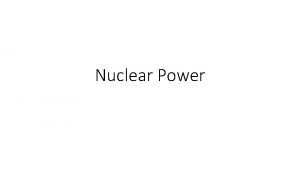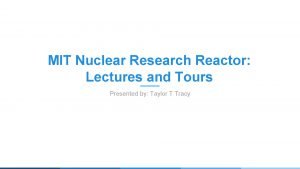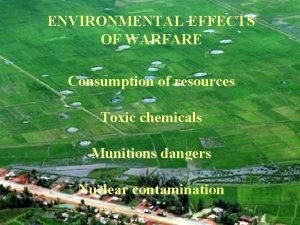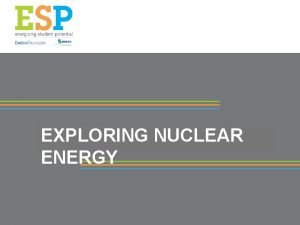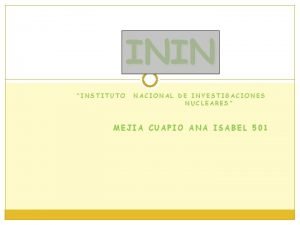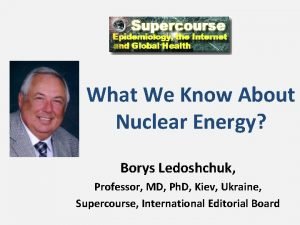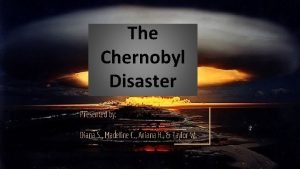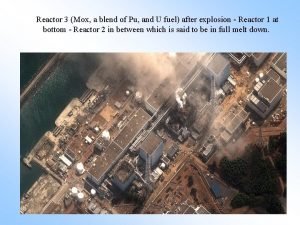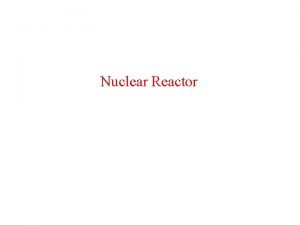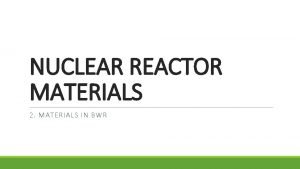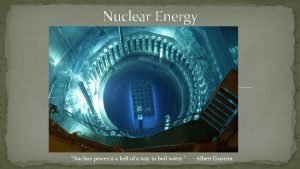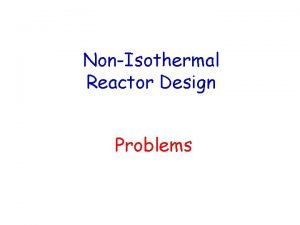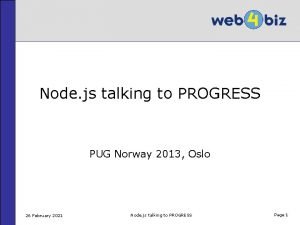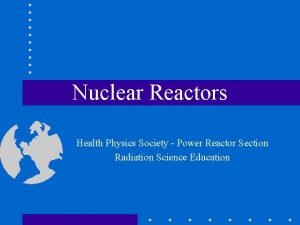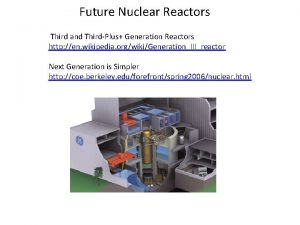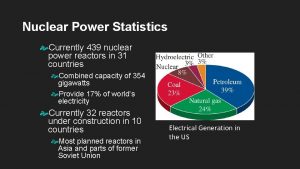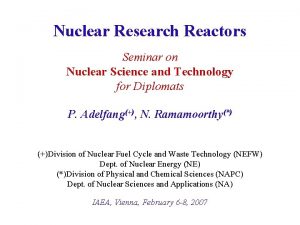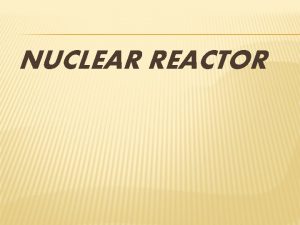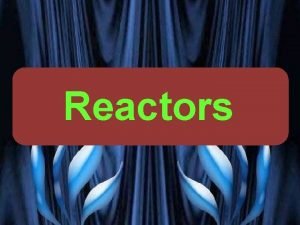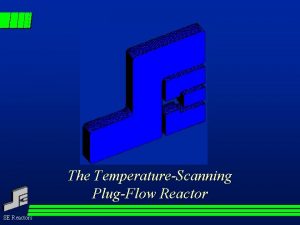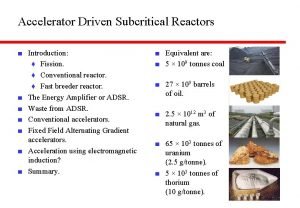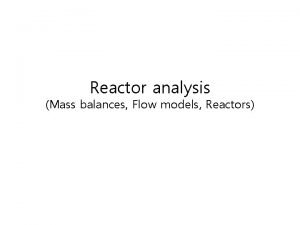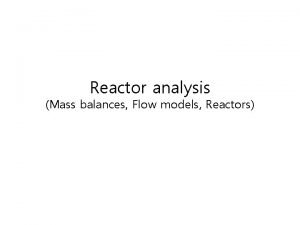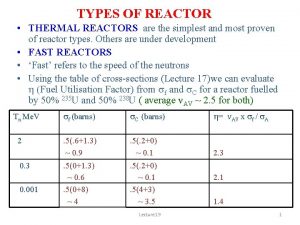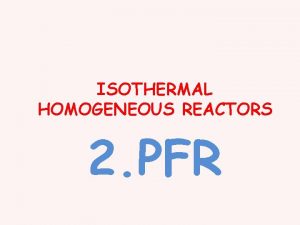Nuclear Power Reactors SEMINAR ON NUCLEAR POWER REACTOR

















- Slides: 17

Nuclear Power Reactors SEMINAR ON NUCLEAR POWER REACTOR GUIDED BY: - E. R. RAGHVENDRA PATHAK Electrical Dept. PRESENTED BY: Vinod kumar E. X-5 th Sem Roll No -0115 EX 081057

CONTENTS 1. Nuclear Reactor 2. Reactor 3. Fission 4. Heat Generation 5. Cooling 6. Electrical Power generation 7. reactor’s classification 8. Classification by Coolant 9. Pressurized water Reactor (PWRs) 10. Boiling Water Reactor (BWR) 11. CANDU Reactor 12. Nuclear power Reactor in India 13. References

What is Nuclear Reactor? A nuclear reactor is a device in which nuclear chain reactions are initiated, controlled, and sustained at a steady rate. The most significant use of nuclear reactors is as an energy source for the generation of electrical power (see Nuclear power) and for the power in some ships (see Nuclear marine propulsion). This is usually accomplished by methods that involve using heat from the nuclear reaction to power steam turbines. There also other less common uses as discussed below.

Reactor The reactor is used to convert nuclear (also known as 'atomic') energy into heat. While a reactor could be one in which heat is produced by fusion or radioactive decay, this description focuses on the basic principles of the fission reactor.

Fission When a relatively large fissile atomic nucleus (usually uranium 235, plutonium-239 or plutonium 241) absorbs a neutron it is likely to undergo nuclear fission. The original heavy nucleus splits into two or more lighter nuclei, releasing kinetic energy, gamma radiation and free neutrons; collectively known as fission products. A portion of these neutrons may later be absorbed by other fissile atoms and trigger further fission events, which release more neutrons, and so on.

Heat Generation The reactor core generates heat in a number of ways: The kinetic energy of fission products is converted to thermal energy when these nuclei collide with nearby atoms. Some of the gamma rays produced during fission are absorbed by the reactor, their energy being converted to heat. Heat produced by the radioactive decay of fission products and materials that have been activated by neutron absorption. This decay heat source will remain for some time even after the reactor is shutdown. The heat power generated by the nuclear reaction is 1, 000 times that of the equal mass of coal.

Cooling A nuclear reactor coolant - usually water but sometimes a gas or a liquid metal or molten salt - is circulated past the reactor core to absorb the heat that it generates. The heat is carried away from the reactor and is then used to generate steam. Most reactor systems employ a cooling system that is physically separate from the water that will be boiled to produce pressurized steam for the turbines, like the pressurized water reactor. But in some reactors the water for the steam turbines is boiled directly by the reactor core, for example the boiling water reactor

Electrical power generation The energy released in the fission process generates heat, some of which can be converted into usable energy. A common method of harnessing this thermal energy is to use it to boil water to produce pressurized steam which will then drive a steam turbine that generates electricity.

Reactor's Classification by type of nuclear reaction;

Classification by coolant; Pressurized water reactor (PWR) Boiling water reactor (BWR) Liquid metal cooled reactor Gas cooled reactor

Pressurized water reactors (PWRs) In a PWR the primary coolant (superheated water) is pumped under high pressure to the reactor core, then the heated water transfers thermal energy to a steam generator. In contrast to a boiling water reactor, pressure in the primary coolant loop prevents the water from boiling within the reactor. All LWRs use ordinary light water as both coolant and neutron moderator.

Boiling Water Reactor (BWR) The Boiling Water Reactor (BWR) is a type of nuclear reactor used for the generation of electrical power The BWR uses demineralization water (light water) as a coolant and neutron moderator. Heat is produced by nuclear fission in the reactor core, and this causes the cooling water to boil, producing steam. The steam is directly used to drive a turbine, after which it is cooled in a condenser and converted back to liquid water. This water is then returned to the reactor core

CANDU ("CANada Deuterium Uranium") The CANDU ("CANada Deuterium Uranium") reactor is a Canadianinvented, pressurized heavy water reactor developed initially in the late 1950 s and 1960 s by a partnership between Atomic Energy of Canada Limited (AECL), the Hydro-Electric Power Commission of Ontario (renamed Ontario Hydro in 1974, and now known as Ontario Power Generation since 1999), Canadian General Electric (now known as GE Canada), as well as several private industry participants. The acronym "CANDU", a registered trademark of Atomic Energy of Canada Limited, stands for "CANada Deuterium Uranium". This is a reference to its deuterium-oxide (heavy water) moderator and its use of uranium fuel (originally, natural uranium). All current power reactors in Canada are of the CANDU type. Canada markets this power reactor abroad.

Nuclear power reactor in India

Nuclear power reactor in India

References ^ http: //cea. nic. in/power_sec_reports/Executive_Summary/2008_12/27 -33. pdf ^ http: //www. reuters. com/article/markets. News/id. USDEL 16711520080818 ^ http: //www. expressindia. com/news/fullstory. php? newsid=65381 ^ http: //www. livemint. com/2008/06/30222448/Uranium-shortage-holding-back. html ^ http: //powermin. gov. in/JSP_SERVLETS/internal. jsp# ^ http: //www. outlookindia. com/pti_news. asp? id=321896 ^ http: //www. rediff. com/news/2008/jan/25 france. htm ^ http: //www. livemint. com/2008/10/09005930/Bush-signs-India. US-nuclearde. html? d=1

THANKS
 Low voltage three phase choke coil filter reactor in pfc
Low voltage three phase choke coil filter reactor in pfc Anatomy of a nuclear reactor
Anatomy of a nuclear reactor Mit nuclear reactor tour
Mit nuclear reactor tour Osirak nuclear reactor
Osirak nuclear reactor What is a nuclear reactor
What is a nuclear reactor Inin reactor nuclear
Inin reactor nuclear Lesson 15 nuclear quest nuclear reactions
Lesson 15 nuclear quest nuclear reactions Fisión nuclear vs fision nuclear
Fisión nuclear vs fision nuclear Fission reactor nuclearcraft
Fission reactor nuclearcraft Chernobyl disaster presentation
Chernobyl disaster presentation Reactor design pattern
Reactor design pattern Reactor pattern
Reactor pattern Magical reactor 3
Magical reactor 3 Reactor working principle
Reactor working principle Boiling water reactor
Boiling water reactor Rbmk reactor design flaws
Rbmk reactor design flaws Non isothermal reactor design problems
Non isothermal reactor design problems Reactor pattern
Reactor pattern

